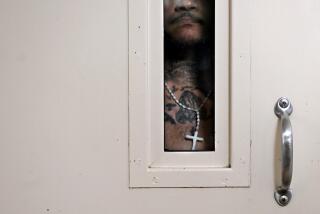San Diego County program for nonviolent felons may be helping to keep people from returning to jail
People serving sentences for nonviolent felonies in San Diego County custody recommit crimes less frequently than those who serve in state prison for similar crimes, according to new data from the San Diego County Probation Department.
Before the 2011 state realignment shifting more nonviolent inmates to county facilities, people returning to San Diego County from state prison went back to prison at a higher rate than for California as a whole, according to the California Department of Corrections and Rehabilitation.
Now, preliminary numbers measuring recidivism, or the returning to crime, suggest that the county has been more successful in rehabilitating the nonviolent offenders.
“In many ways, San Diego as a community is ahead of the game if you compare to other communities across the country,” said Ricky Valdez, vice president of programs at Second Chance, an organization that helps people transition back to life outside of prison.
He said organizations involved in rehabilitation are launching programs that would have been unheard of even five years ago.
“Partners are starting to think outside the box and admit the way we have been doing reentry in our community is not working, so we need to look at other ways to do it,” he said.
Since California passed Assembly Bill 109, the public safety realignment law that shifted where sentences were served for nonviolent, nonsexual, nonserious offenders, San Diego County has been responsible for rehabilitating two groups: those who serve their sentences locally and those who serve their sentences in state prison but are supervised by the county probation department after release.
Fourteen percent of individuals released in 2015 who were supervised from start to finish at the local level committed new crimes while still under probation supervision, according to the probation department. That same year, of those who served in state prison but were supervised locally post-release, 36% committed new crimes while on probation, more than double the percentage.
Scott Huizar, a division chief with the probation department, said that the two populations are similar in terms of crimes committed, but they differ by when those crimes were committed. If they committed their crimes before the implementation of AB109, they served in state prison, but if they committed those crimes after AB109, they served locally.
Huizar credited the low recidivism rate for those serving locally to the programming that they received while incarcerated.
“It’s a collaborative approach to address the supervision effort,” he said. “They’re provided with a number of resources.”
The most recent recidivism rate published for prisoners returning to San Diego County by the California Department of Corrections and Rehabilitation cannot be directly compared to the new numbers from the probation department because the two organizations measure recidivism differently.
The state measures recidivism by looking at whether or not an individual returned to prison within three years of release, rather than whether the person reoffended while still under supervision.
San Diego’s work in reducing recidivism has captured the attention of the federal government. The Department of Labor recently awarded the county one of 19 grants across the nation to establish a job center inside the East Mesa Reentry Facility. Second Chance, along with the San Diego Workforce Partnership, helps run the program.
kate.morrissey@sduniontribune.com
Morrissey writes for the San Diego Union Tribune
ALSO
Arizona woman dies after car-to-car shooting in Pomona
Case against Trump University should move forward, judge rules
More to Read
Start your day right
Sign up for Essential California for news, features and recommendations from the L.A. Times and beyond in your inbox six days a week.
You may occasionally receive promotional content from the Los Angeles Times.






